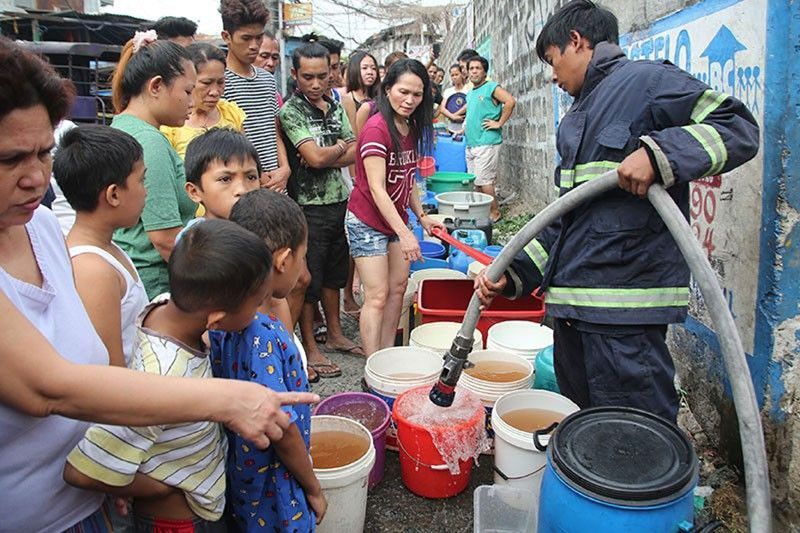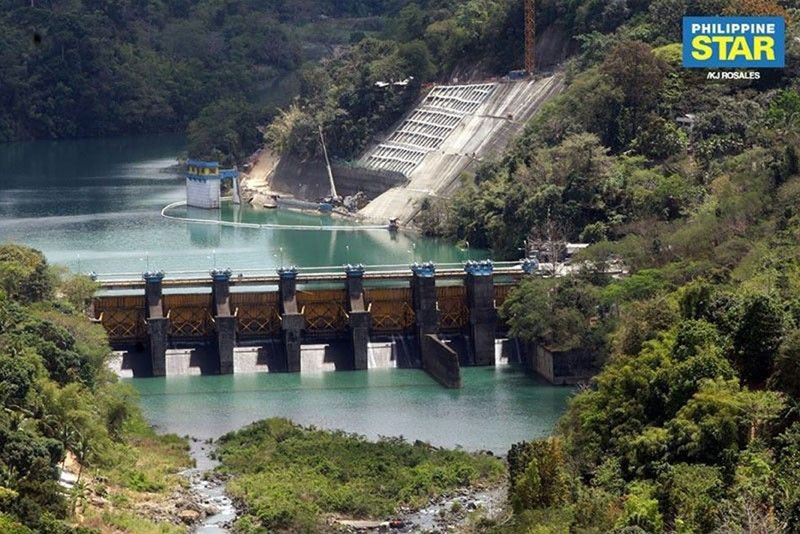Duterte wrath, water woes mark 2019

MANILA, Philippines — This year was marked by two major stories in the water sector: a waterless Metro Manila and the country’s major utility firms incurring the wrath of President Duterte.
Last March, Metro Manila suffered the worst water crisis in years, leaving families to wait hours to get their daily water supply from tanker trucks.
While the water shortage problem eased, concerns still persist as Ayala-led Manila Water Co. and Maynilad Water Services Inc. face an uncertain future after the government moved for a review of their contracts, which Duterte alleged were laden with provisions that were disadvantageous to the public.
Maynilad president and chief executive officer Ramoncito Fernandez said 2019 has been challenging for the company and the industry as a whole.
“It was a very challenging year, but we would rate good performance in terms of how the company has handled the crisis. What happened in March was not even caused by us, that should be very clear,” Fernandez told The STAR.
Too little rain, a growing demand, and delays in expanding water infrastructure caused the water supply crunch.
The water supply crisis has put a severe dent in Manila Water’s bottom line. Adding to its woes is the P1.13 billion penalty imposed by the Metropolitan Waterworks and Sewerage System (MWSS) for failure to provide 24/7 water supply to its customers.

Angat Dam
Metro Manila sources 96 percent of its supply from Angat Dam, which has been receding over the last years.
In 2019 it hit record lows, after exacerbated by the El Niño episode.
The dam started declining in April amid El Niño and eventually reached the critical level in June. This triggered several weeks of interrupted water service connection across Metro Manila and its neighboring provinces.
“We responded positively to the reduced allocation of Angat and we have identified mitigating measures to help us address effects of possible continued low water source allocation,” Fernandez said.
According to the National Water Resources Board, lesser allocation is needed to preserve the dam’s water elevation and reach the target yearend level of 212 meters.
And if even the Philippines experiences typhoons moving forward, projections showed Angat would continue to operate below its maximum normal capacity until June 2020 when the next dry season would have culminated.
Until 2021, Metro Manila’s water demand is expected to outstrip supply by as much as 13 percent during peak days.
It is only in the next three years that projected water supply of 5.89 billion liters a day will begin exceeding demand of 5.24 billion liters a day, but this is highly dependent on the controversial P12.2 billion Kaliwa Dam becoming operational.
Kaliwa Dam
“If you look back at history, Kaliwa dam has been in the masterplan of government for decades, unfortunately, because we have ample rains in the past, the government did not focus on getting another source,” Fernandez said.
“But with climate change here and real, the government is realizing that they should have acted faster,” he said.
The Metropolitan Waterworks and Sewerage System already asked the Department of Interior and Local Government to speed up the issuance of permits for new water sources projects amid the continued supply crunch in the metro.
Despite it being a new water source, the China-funded mega dam continues to face resistance from groups due to the issue of ancestral domain rights of indigenous peoples. in the area.
MWSS recently secured its environmental compliance certificate, a requirement needed by any project in the country that poses potential environmental risk or impact.
The ECC covers the construction and operation of a gravity dam along Kaliwa River located in the towns of Teresa and Tanay in Rizal province, and General Nakar and Infanta in Quezon.
The dam will be 60-meter tall with a riverbed elevation of 100 meters. Its reservoir surface area will cover some 291 hectares at full supply level volume of 57 million cubic meters.
MWSS has reoriented its priorities and adopted a raw water security roadmap that will provide potable and sustainable water supply in the next five to 50 years which will translate to at least 1,518 million more liters per day by 2022.
Among the projects being fast tracked are the 150 MLD Putatan, 100 MLD Cardona, 188 MLD Sumag, 50 MLD Rizal Wellfield, 80 MLD Calawis Wawa, 100 MLD Putatan 3, and 250 MLD Lower Ipo.
All these projects including the Kaliwa Dam are expected to be completed in 2023.
Eyed as medium-term water source projects from 2023 to 2027 are the 420 MLD Wawa Dam, 250 MLD East Bay, 350 MLD Bayabas Dam, 550 MLD Angat Norzagaray Phase 2, 250 MLD East Bay, 750 MLD Sierra Madre, and 1,800 MLD Kanan River Phase 1.
MWSS also expects too complete by June 2022 Aqueduct 7 and Tunnel 5 which are now on stream to provide another 1,600 MLD to flow towards La Mesa.
An off take agreement between Manila Water and Prime Metroline Infrastructure Holdings Inc. has also been approved to pursue the development of a water supply source east of Metro Manila, the Wawa Bulk Water Supply Project.
Government vs. water firms
Above it all, President Duterte’s tirade against the two concessionaires had caused public alarm.
The MWSS cancelled the extension of the concession agreement forged with the two firms, which is seen to result in higher water rates after 2022.
“The price of water is related to the capacity of the company to invest and to improve, that’s what needs to be talked about. Everytime we are challenged, our capacity to invest, to get financial support will also be challenged,” Fernandez said.
Duterte’s latest rage stemmed from the decision of an international abritral court which directed the Philippine government to pay the two utility firms over P10 billion for non-implementation of rate hikes.
Duterte sought for a review of the concession deals and the removal of onerous provisions.
“We have already done our spending plan in the presumption that we can recover what we have spent and that the longer the recovery period is, the lower the tariff that can be passed on to consumers,” Manila Water Board Member and former president and CEO Tony Aquino said.
“The government as represented by the Regulatory Office and MWSS are always a party on the setting of rates. It is not unilateral and we are not the only ones computing the tariff,” he added.
The MWSS board revoked the resolution granting the 15-year extension of the contracts of the two concessionaires until 2037. This means the contracts will end by 2022, which was the original expiration date.
“There has to be a lot of discussion and cooperation moving forward. We have expressed willingness to sit down so we could understand the rationale behind it and make solutions together,” Fernandez said.
“For now, we motivate our people to not be distracted by the noise, and just focus on giving good service to our customers. Customers are more demanding, the climate change has been erratic affecting our operations and the regulatory environment has also been unpredictable,” he added.
The real deal with privatization
Amid all the mess, IBON Foundation, a non-profit research, education and information-development institution, maintained that things would remain unsettled if the government sticks to its water privatization policy.
It was in 1997 when former president Fidel Ramos solicited bids for concession agreements with MWSS to address the water crisis in Metro Manila that existed due to the failure of the MWSS to maintain viable operations owing to technical inefficiencies and financial debts.
IBON Foundation executive director Sonny Africa said water rates increased by seven-fold under Maynilad and ten-fold under Manila Water.
The United Nations Development Programme believes water costs should not exceed three percent of household income.
Yet a study conducted by the Water for People Network found out that poor families in Metro Manila are paying as much as 22 percent of their household income for water.
“Under an unchanged framework of privatization, there are reasons to doubt whether government’s renegotiated concession agreements will be able to completely rectify the problems. The basically profit-driven approach is inappropriate and will inevitably result in contracts still unnecessarily skewed towards ensuring private profit even at the expense of social objectives,” Africa said.
“Privatization means having public utilities and social services run by the private sector. The private sector is assumed to be inherently more efficient than the public sector and, hence, able to provide the utility or service better. The better services, it is argued, justify the more expensive prices and resulting profits,” he said.
IBON Foundation argued that there are around 500 large cities worldwide with a population of over one million, including the big cities in Metro Manila. Despite the wave of water privatization starting in the 1990s, 82 percent of these cities and their populations are actually still served by public providers.
“Nationalization is the real alternative to water privatization. It is the best way to ensure that water is provided as a service instead of operated as a business,” Africa said.
“The concession agreements should be terminated as the starting point for returning Metro Manila water services to full public ownership, management and control. Government officials and the water firms should also be held accountable for over two decades of water service misdeeds,” he said.
Until such time the government decides on what to do with the country’s water services, or if it could actually do something about it, consumers might still have to brace for waterless days.
- Latest
- Trending




























